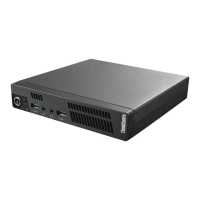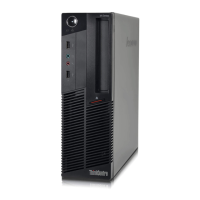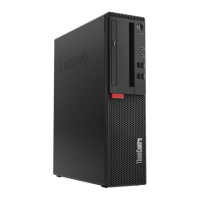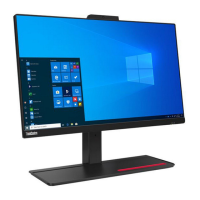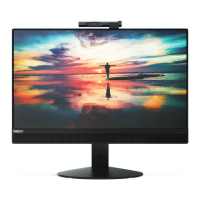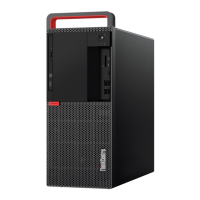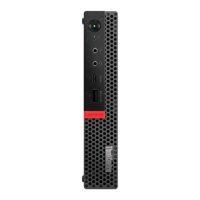












Do you have a question about the Lenovo ThinkCentre M90 and is the answer not in the manual?
| Tcase | 72.6 °C |
|---|---|
| Bus type | DMI |
| Stepping | C2 |
| Tjunction | 100 °C |
| Processor cache | 4 MB |
| Processor cores | 2 |
| Processor model | i3-530 |
| System bus rate | 2.5 GT/s |
| Processor family | Intel® Core™ i3 |
| Processor socket | LGA 1156 (Socket H) |
| Processor threads | 4 |
| Processor codename | Clarkdale |
| Processing Die size | 81 mm² |
| Processor frequency | 2.93 GHz |
| Processor cache type | Smart Cache |
| Processor lithography | 32 nm |
| Processor manufacturer | Intel |
| Processor front side bus | - MHz |
| PCI Express slots version | 2.0 |
| Processor operating modes | 64-bit |
| ECC supported by processor | No |
| PCI Express configurations | 1x16, 2x8 |
| Thermal Design Power (TDP) | 73 W |
| Processor core voltage (AC) | 0.95 - 1.30 V |
| CPU multiplier (bus/core ratio) | 22 |
| Maximum number of PCI Express lanes | 16 |
| Number of Processing Die Transistors | 382 M |
| Memory bandwidth supported by processor (max) | 21 GB/s |
| Maximum internal memory supported by processor | 16 GB |
| Internal memory | 2 GB |
| Memory channels | Dual-channel |
| Internal memory type | DDR3-SDRAM |
| Maximum internal memory | 8 GB |
| Memory layout (slots x size) | 1 x 2 GB |
| HDD interface | SATA |
| Optical drive type | DVD-RW |
| Total storage capacity | 320 GB |
| Networking features | Gigabit Ethernet |
| Intel segment tagging | Enterprise, Professional |
| On-board graphics card | Yes |
| Discrete graphics card model | - |
| Maximum graphics card memory | 0 GB |
| On-board graphics card model | Intel® HD Graphics |
| On-board graphics card base frequency | 733 MHz |
| Audio system | High Definition Audio |
| Product type | PC |
| Operating system installed | Windows 7 Professional |
| USB 2.0 ports quantity | 8 |
| Firewire (IEEE 1394) ports | 0 |
| Cabling technology | 10/100/1000Base-T(X) |
| Power supply | 240 W |
| Chassis type | Tower |
| Product color | Black |
| Processor ARK ID | 46472 |
| Processor package size | 37.5 x 37.5 mm |
| Graphics & IMC lithography | 45 nm |
| Supported instruction sets | SSE4.2 |
| Physical Address Extension (PAE) | 36 bit |
| Depth | 99 mm |
|---|---|
| Width | 317 mm |
| Height | 355 mm |
| Weight | 7500 g |
Details system specifications, including processor, memory, drives, and subsystems.
Covers system information across multiple models, use Setup Utility for specific details.
Lists supported Intel Core and Pentium microprocessors.
Details support for DDR3 SODIMMs and maximum memory capacity.
Information on optical drives and hard disk drives (SATA).
Describes integrated graphics card, VGA, and DisplayPort connectors.
Details integrated HD audio, line-in/out, microphone connectors.
Lists Ethernet, modem, and USB connectivity features.
Covers system management features like POST, boot-up, and AMT.
Details I/O ports like USB, Ethernet, DisplayPort, serial, PS/2, VGA.
Information on available expansion slots like PCI and drive bays.
Details AC power supply wattage and ACPI support.
Covers system security features like chassis intrusion, passwords, and cable locks.
Lists pre-installed software for enhanced productivity and maintenance.
Details pre-installed operating systems like Windows 7, Vista, and Linux.
Provides detailed technical specifications for the system.
Specifies the system's physical dimensions (width, height, depth).
Indicates the system's weight when shipped.
Details environmental conditions for operation and storage.
Specifies temperature ranges for operating and non-operating conditions.
Specifies humidity ranges for operating and non-operating conditions.
Specifies altitude ranges for operating and non-operating conditions.
Lists useful Lenovo software for system management and maintenance.
Provides guidance to system information and tools for easy and safe operation.
Guides users to system information and tools for setup, operation, and maintenance.
Offers innovative Lenovo features and guides for important setup tasks.
Self-recovery solution with tools for diagnosing issues and recovering from failures.
Protects sensitive information like passwords and encryption keys.
Helps fill in authentication information for Windows applications and websites.
Provides full control over system power for optimal performance and energy saving.
Enables restoring factory default settings for the hard disk drive.
Uses integrated fingerprint reader for secure system access and password replacement.
Helps maintain, secure, and troubleshoot the system, offering innovative technologies.
Diagnostic tool for troubleshooting system issues and reporting failures.
Utility for viewing, printing, and searching PDF documents.
Helps detect and limit viruses for system protection.
Provides diagrams and descriptions of system component locations.
Diagrams showing the location of front panel connectors.
Diagrams showing the location of rear panel connectors.
Diagrams showing the location of internal system components.
Precautions for safely handling electronic components to prevent static damage.
Step-by-step guide on how to safely open the computer's chassis.
Instructions for removing and reinstalling the front bezel assembly.
Guides on how to install or replace system memory modules.
Detailed steps for replacing the system's hard disk drive.
Instructions for removing and installing an optical drive.
Steps for replacing the system's CMOS battery.
Procedure for replacing the system's heat sink assembly.
Instructions for removing and installing the internal speakers.
Steps for replacing the front USB assembly and audio connector.
Guide on how to replace the AC power supply unit.
Instructions for replacing the bezel for the AC power supply.
Steps for replacing the system's keyboard or mouse.
Final steps for reassembling the system after component replacement.
Information on how to get device drivers from Lenovo's website.
Instructions for installing system security features like cable locks.
Details on using the integrated cable lock for physical security.
Guides for creating and using recovery media for system restoration.
Instructions for creating recovery media on Windows 7 and Vista.
Steps for restoring the system using recovery media.
Information on performing system backups and restorations.
Detailed steps for creating a system backup using Rescue and Recovery.
How to use the workspace for system recovery and data retrieval.
Steps to restore the system from a backup using Rescue and Recovery.
Guides for creating and using rescue media for system recovery.
Steps to create bootable rescue media (disk or USB).
Steps to use rescue media to boot and recover the system.
Solutions for common recovery issues and system boot problems.
Information on diagnostic tools for hardware testing.
Tool for system maintenance, security, and troubleshooting.
Diagnostic tool for system recovery when Windows fails to boot.
Diagnostic utility for troubleshooting hardware issues without an OS.
Steps to create a bootable diagnostic disk.
Instructions to boot and run diagnostics from a created disk.
Guide on how to clean the optical mouse sensor for better performance.
Instructions for accessing and starting the system setup utility.
How to navigate and modify system configuration settings.
Guides on setting, changing, and deleting system passwords.
Recommendations for creating strong and secure passwords.
Secures system startup by requiring a password before booting.
Restricts access to system configuration settings.
Protects data on the hard disk drive by requiring a password.
Procedure for managing system passwords.
How to enable or disable system devices like USB and SATA ports.
How to select or change the order of boot devices.
How to select a boot device for a single startup.
Instructions for saving changes or exiting the setup utility.
Overview of system software including BIOS, POST, and Setup Utility.
Steps to update the system BIOS using a bootable disk.
Instructions to update the system BIOS from within the OS.
Procedure to recover the system from a failed POST or BIOS update.
Table of common problems and their solutions.
Information on diagnostic tools for hardware testing.
Tool for system maintenance, security, and troubleshooting.
Diagnostic tool for system recovery when Windows fails to boot.
Diagnostic utility for troubleshooting hardware issues without an OS.
Steps to create a bootable diagnostic disk.
Instructions to boot and run diagnostics from a created disk.
Guide on how to clean the optical mouse sensor for better performance.
Lists resources for obtaining system information and support.
Accessing online manuals and PDF documentation.
Tools for system management, maintenance, and easy operation.
Provides system information and tools for easier system use.
Guides users through setup and helps maximize system benefits.
Information on system setup, basic tasks, and troubleshooting.
Details safety precautions, setup, warranty, and notices.
Accessing Lenovo's website for product information and support.
Information on obtaining technical support and service.
Details on purchasing additional services like hardware support and software.
Lists Lenovo trademarks and other company/product marks.

